 |
 |
This Scania T164G-580 8x4 tractor belongs to the company Eriksen & Sønner as from Oslo, Norway. |
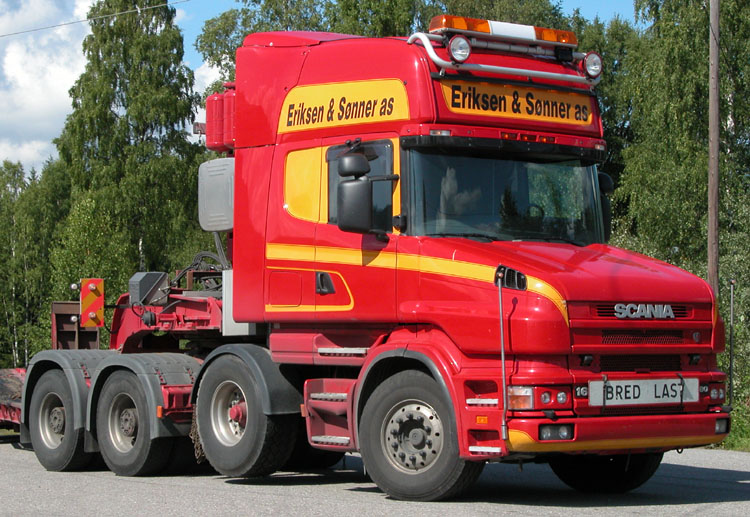 |
This is the first Scania Torpedo thas was delivered with the ZF WSK 440 and Ecosplit 16S251 gearbox. Laxa delivered it as a 6x4 tractor, a company in Sweden then mounted the 4th axle afterwards.
|
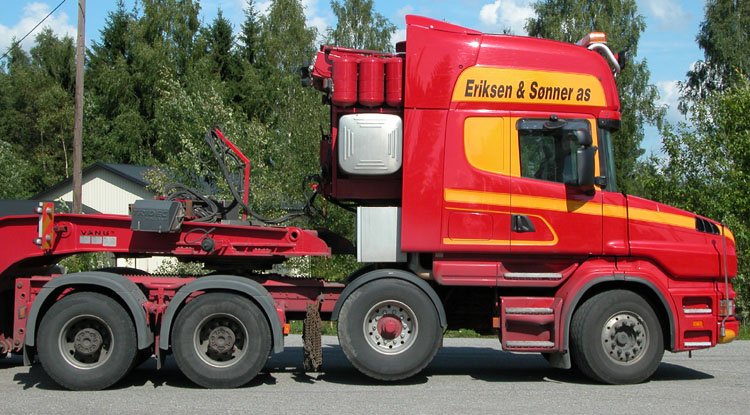 |
This 4th axle is a 12 tonnes SAF unit. If the axle is lifted it doesn’t steer anymore, as can be seen here. The axle is placed 1,85 mtr (about 6 feet) in front of the first rear axle. This is necessary to become these 12 tonnes (bridge formula). |
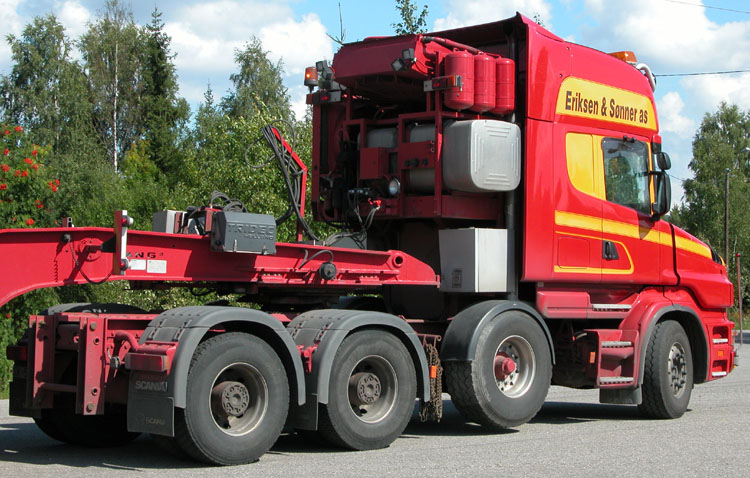 |
At the rearside of the chassis we see these remarkable vertical steel beams. A additional 5th axle can be connected to these beams, this converts it to a 10x4 tractor. This axle can, depending on regulations, have an axle-load of up to 13 tonnes. The tractor can then reach a total weight of 60 ton. Axle loads are then: 9 - 12 - 13 - 13 - 13 (tonnes). |
 |
Behind the tractor hangs a Vang’s trailer, a trailer manufacturer from Norway. Here we see the trailer as a 3-axled unit. It can be extended with 2 more axles and so make it a 5-axled one. Total combination weight can reach approximately 130/135 tonnes. The trailer is equiped with a steering system of Tridec from Holland.
|
 |
Behind the cab we see the large tower with additional cooling, dieseltank etc... More about this on page 2. |
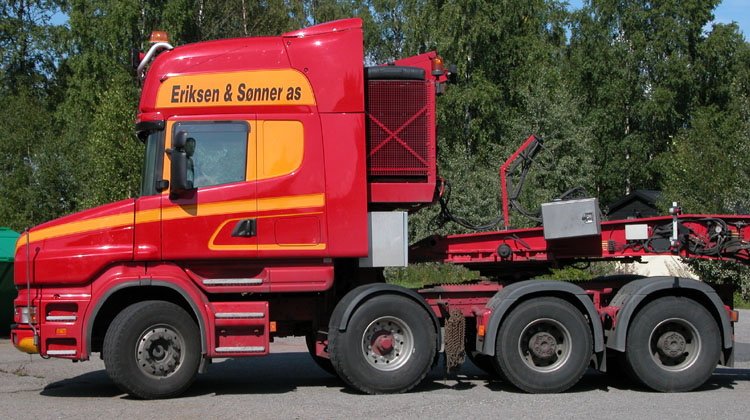 |
At this torpedo they, just like Ligro’s T164G-580, adjusted the tower so that the gooseneck of the trailer can turn freely. In this case they moved the entire tower upwards. The tractor is equiped with a long slidetable for it’s fifth wheel and even the trailers kingpin can slide in the gooseneck. This is all necessary so that the trailer can also be used when the 5th axle is mounted to the tractor.
|
 |
Here we see the truck with the 2nd axle on the ground. It now steers in the same direction as the front axle. The axle is steered hydraulically. The mud guards move with the wheels on these axles. |
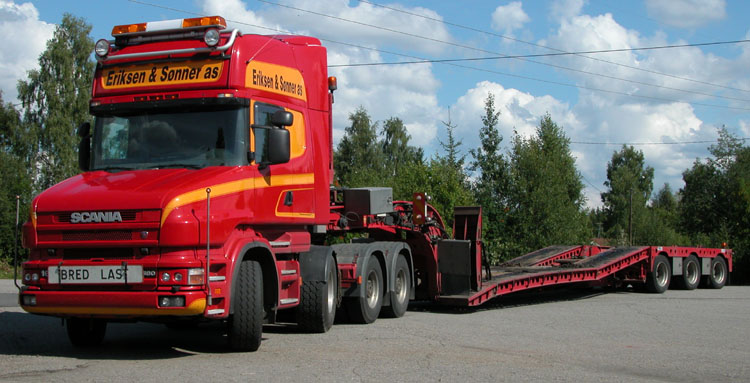 |
One the most impressive trucks of my vacation!!
Or, as the driver said it “Probably the heaviest Scania of Europa....”
|
The Modifications |
Because this truck has some very interesting features I decided to write some more about it.
|
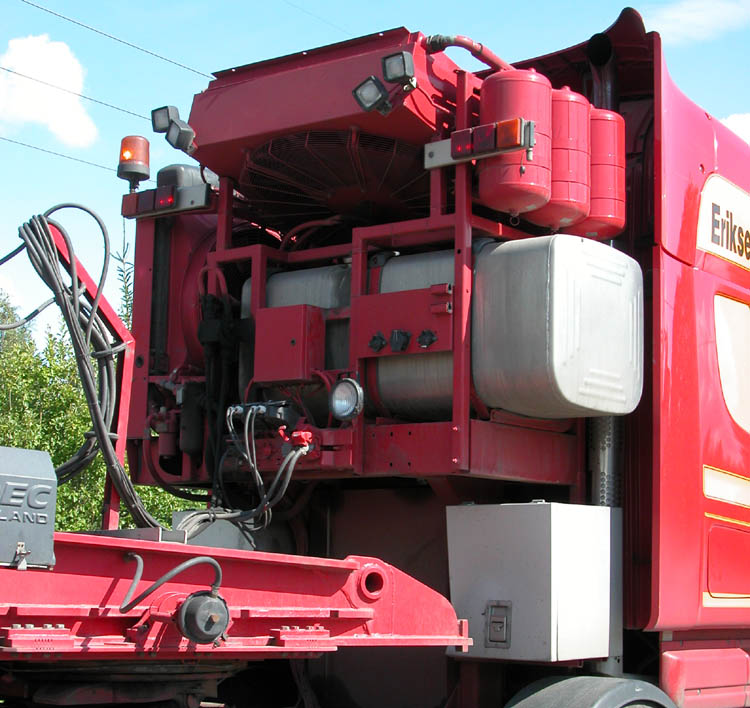 |
 |
Behind the cab we find the tower with 2 large coolers and a dieseltank. Below the tower they placed 2 small toolboxes and a tank for the hydraulic oil. The cooler that is standing on the left side is the standard cooler that Scania (Laxa) uses for these kind of trucks. It is a water-air cooler that cools the water of the engine. Behind the cooler is a cooling fan that blows the air through the cooler.
For the gearbox we, as an exception, find 2 coolers on this truck. The first one isn’t visible on these pictures and is the standard heatexchanger (oil-water) of ZF that can be found on any Scania with WSK. Normally it is mounted below the tower, but with the torpedo it is mounted underneath the cab. The cooler that makes this Scania so special is the large one that we see on top of the tower. It is a extra oil-air cooler that can be added to the gearbox cooling system via a bypass, and can therefore be opened when it is needed. The cooling fan of this cooler is driven hydraulically and the speed of it can be regulated by the driver. The cooler is made by Oiltech and has, according to the driver, a cooling capacity of up to 400 kW.
This large cooling system is neccesary because of the topography of Norway. In Norway you can find very long downhill roads that can go on for more than 10 km with a slope of about 7 to 9 %. A transport with more than 100 tonnes weight has to drive slow on these roads, this can only be reached with continuous braking. The WSK 440 has a primary retarder, this is a hydraulic brake that is mounted in front of the gearbox in the torque converter housing. This hydraulic brake can brake via the driveline without wearing out the normal brakes (wear-free braking). The braking power is converted into heat. This heat comes into the oil and has to be cooled somehow. That is why it needs these 2 large coolers.
|
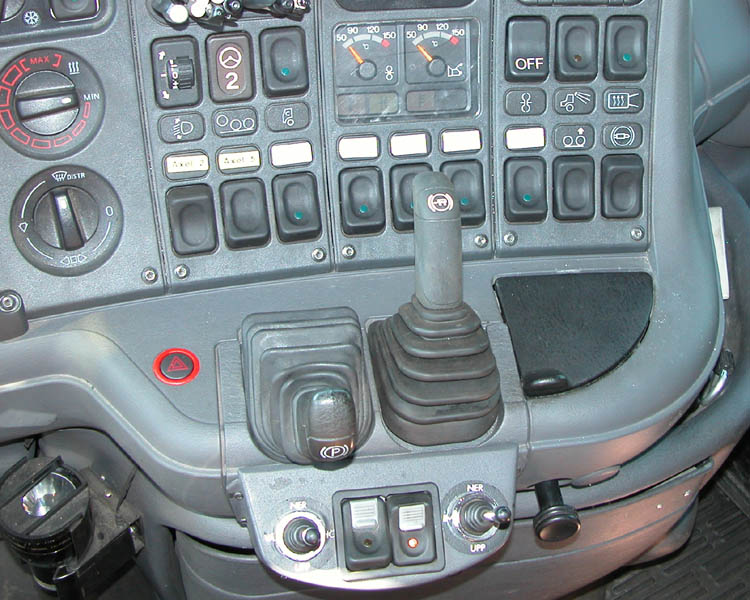 |
On the dashboard we see some changes in comparison to a normal torpedo. Both gauges we see on the top right part show retarder-oil temperatures. One shows the cooler outlet- and the other shows retarder outlet temperature. By looking at these temperatures the driver decides how fast he will let the cooler-fan of the oil-air cooler run.
Below these gauges we see a row of switches. These switches can be used to dump the suspension-load of axles. So, the axle doesn’t has pressure on it’s bellows. This is a feature for the winter time where streets can become slippery and you need more axle load on the driven axles. The first 2 switches dump the load on the 2nd and the (mountable) 5th axle of the truck. The other 5 are for all 5 trailer axles.
Also there is a switch here that can activate the engine cooling fan.
With the panel that is mounted below the parking- and trailer brake (this panel is from Scania and is normally used to control a snow plow) the driver can steer the trailer by hand. |
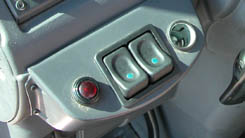  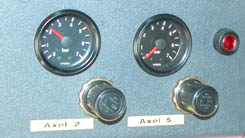 |
To the left of the steering column we find the switches which activatie the oil-air cooler and it’s cooling fan.
Below that panel there is a switch (middle picture) which deactivates the brake pressure of the front axle of the tractor. This is also usefull in the winter time on slippery roads, where a truck easily gets out of control during braking (skidding of the tractor).
Above the windscreen there are two gauges that show the bellow-pressure of axle 2 and 5 of the tractor. With the regulators beneath them the pressure can be adjusted. |
Thanks a lot to the driver of this truck for the photo-session
and the large amount of information about his truck |
| |
| Back to the Scania index |